Fiddle figs are one of the most popular, eye-catching plants in any home or office. These lush, beautiful plants make a striking impact. They have become the ultimate plants to have in your home or office thanks to the influence of social media. But when things start to go wrong and your fiddle leaf fig begins to look sickly, you need to know what to do. Fiddle Leaf Figs are notoriously finicky plants, so maintaining one without any experience can seem daunting at first. But with the right routine, and ensuring you don’t under or overwater your plants, you can keep your fig happy and growing beautiful and boldly. Today we are going to discuss our 15 best tips to grow a healthy fiddle leaf fig tree.
What is a Fiddle Leaf Fig?
Native to tropical parts of Africa, the fiddle leaf fig has large, heavily veined, leave. They thrive in warm, wet conditions, making them challenging for novice plant owners when it comes to duplicating the fig’s ideal, steamy conditions. Fiddle leaf figs are the perfect focal points for your home and garden. They look gorgeous in modern metallic pots and in all styles of home décor, which is why they continue to be popular despite their difficult care.
It is important to know, though, that a fiddle leaf fig can grow to at least 6 feet tall with some even reaching 10 feet. As a result, you need to ensure you place your plant where it has enough room to grow. Below we will discuss how to care for these gorgeous but finnicky plants.
1: Ensure your Fiddle Leaf Fig Tree Has Perfect Drainage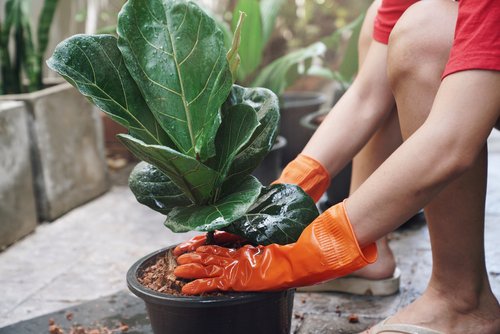
Proper drainage is one of the most common mistakes new plant owners make. They plant their fiddle leaf in a container without proper drainage. You need to ensure your plant is in a pot with drainage holes. Their roots need to be relatively dry and will suffer if the soil is too moist. As a result, never try to grow your fig in a container with no drainage and ensure the soil dries out between watering.
2: Use a Fast-Draining Soil
Your fiddle leaf fig plant loves fast draining soil because it is very susceptible to root rot and other bacterial infections. These infections occur when the root system gets too soggy. So to ensure your fiddle leaf stays healthy, make sure you use a fast draining soil. This soil can also provide aeration so the roots can breath.
3: Sunlight to Grow a Healthy Fiddle Leaf Fig Plant
As these plants originate from Africa the love sunlight and need plenty of it to thrive. Place your fiddle leaf fig next to south facing windows that will give the fig at least 8 or more hours of indirect sunlight per day. Try to avoid direct sunlight, however, as this can burn the leaves. So try to place the plant in the sunniest spot in the room, without roasting the leaves of the plant.
4: Always Water Carefully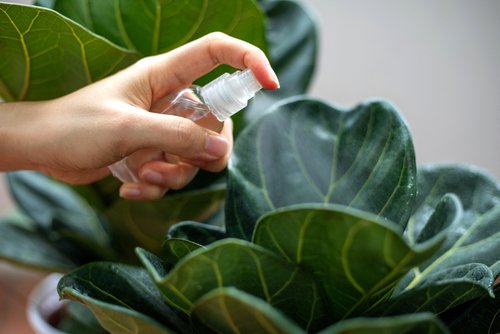
As we mentioned, one of the most common causes for fiddle leaf figs dying is overwatering. Poor drainage and lack of sunlight can make this problem worse. You shouldn’t water your plant more than once week and only water if the soil feels dry – you need to let the root system dry out between watering.
5: What is Aerating Soil?
In the wild, natural decomposition and earthworms are constantly aerating the soil. This is done by how they churn up the dirt and soil, in order to get more air into the soil. This is important to keep the oils healthy. But when a plant is in a pot, there are no natural processes to get air to the roots. In a pot the soil becomes compacted over time as you water regularly and the plant’s roots grow.
To stop your plants becoming suffocated, it is important to get fast draining soil as it tends to aerate better. Using wooden skewer or chopstick to gently loose or poke holes to create the perfect aeration for your plant!
6: You MUST Feed Your Fiddle Leaf Fig
Due to their large leaves and incredibly fast growth, it is no surprise they have big appetites. You need to feed your fig on a regular basis with a good houseplant fertiliser. Any decent formula for houseplants should be fine but your fiddle leaf fig will do best with a 3-1-2 formulation. This can be used every time you water your plant.
7: Schedule Your Plant Care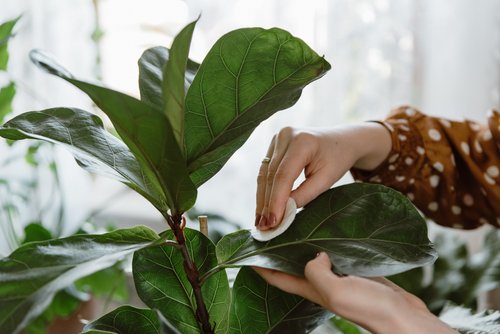
Pick one day of the week and stick to that day as the day to care for your plants. This way, like any other habit, caring for your plant will become second nature to you. We recommend a Friday evening or weekend day, when you’re not stressed by work or other life matters.
8: Repotting Fiddle Leaf Fig
You will know a fiddle leaf fig is ready for repotting once the roots start peeking out of the bottom of the pot. At this point you can either repot it in a slightly larger pot, or trim the root ball. Trimming the root ball is a good alternative if you are a skilled gardener and you want the fig to stay the same size it is. Make sure you don’t trim back more than 20% of the fig’s roots or you might damage the root system.
9: Pruning
Cutting back a few leave every now and then will encourage your fiddle leaf fig to grow. Start by pruning back any undamaged leaves so your plant can focus on providing nutrients for its healthy leaves. You should also cut out any crossing branches since the fig needs breathing room for healthy growth. You can also prune the free to take on a specific shape or height to suit your space – don’t forget, these plants can grow to over 2m tall.
When pruning your tree, ensure your cuts are at least an inch from the trunk so you don’t inflict damage to the trunk. Usually two branches will sprout from the cutting is the fig is healthy. Make it a habit to prune your tree when you notice overgrowth, to keep it growing strong.
10: Cold Temperatures
The fiddle leaf fig is a jungle plant. This means it likes it hot. Which is perfect for these long, hot Australian summers, but not so much for winter. These plants also hate cold drafts which, in winter, is generally where the plant is placed – like up close to a window to make the best of the winter sun. These drafts can also dry out a room which isn’t just bad for your fig, it is bad for you, especially your skin! Fixing any drafts will make your home more steamy, which is better for your fig, and you!
11: Do NOT Cut Off the Growing Bud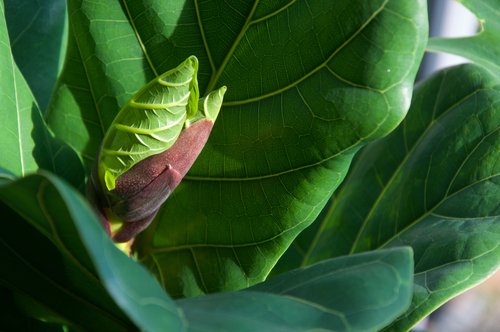
A fiddle leaf fig will often have a dry, crispy brown sheath at the top of the plant. Too many people assume that this piece of the plant is dead. This is, however, a totally normal part of the plant and should not be cut. When the plant grows new leaves, they will emerge from this dry little bud. If you do cut this growing tip off, the plant will need to form new buds somewhere other than the top point. This can result in the plant growing heavy branches. But once cut, no new growth will come from the cut bud itself.
12: Dry Air
Dry air or even people brushing past the plant may cause brown tips on the leaf edges. To increase the humidity you can mist the leaves regularly and move the plant so that it’s not in any walkways. Wipe down any dusty or dull looking leaves with a clean, damp cloth. Use water only and allow the leaves to dry. You can apply a leafy shine to the upper surface of more mature leaves. And commonly encountered pests like mites, scales, and mealy bug and be controlled with an insecticide.
13: Leaf Discolouration
There are a number of discolouration issues your plants can experience. These include:
Brown Sports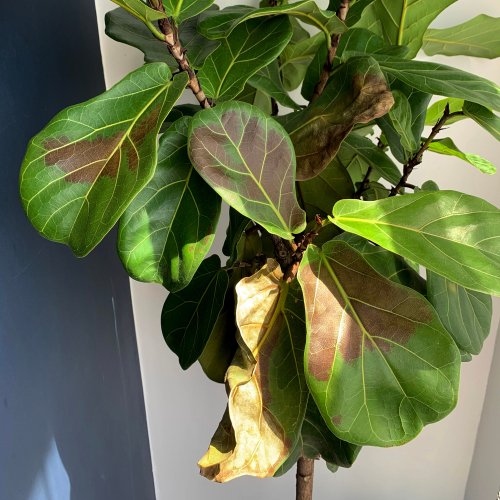
If you notice brown spots starting to appear on your fig’s leaves, it is the plant’s way of calling for help. While it could mean many different things, it is generally a sign you are overwatering your fiddle leaf. So cut back on watering for a little while.
Drooping Leaves
Severe hydration is the most common cause of drooping leaves. It means your plant is in shock. This could be that you’ve moved your plant, or that the plant is severely dehydrated.
Yellow Leaves
If your plant has yellow leaves, this is a sign of stress. It is either underwater or overwatered. But stress can also occur if you have moved your fiddle leaf fig to a new pot or if you have recently repotted.
14: Propagation
Want more of your beautiful fig, without buying a whole new fig? Looking to share the love with some friends? Propagating a fiddle leaf fig is easy. Find a branch with a couple healthy leaves right above where the leaves connect with the tree. This is known as the node. Put this cutting in filtered water and stick it in a sunny spot. Replace the water whenever it begins to look dirty or cloudy. Your cutting should develop roots after about a month. Pot the cutting when the roots are a few inches long.
15: Bonding with Your Fiddle Leaf Fig
This may sound really strange but did you know that bonding with a plant is critical to its health? You should get to know your plants, give them a name like a pet, and check up on it each week for signs of stress and disease. Plants thrive on attention, so ensure you give your plant a little extra love.
While caring for a fiddle leaf fig is no easy task, you will definitely earn a sense of pride by growing a healthy fiddle leaf fig. a truly flourishing fig will not only make you feel accomplished, it will impress anyone who steps through your door. Aumman’s can help you with everything you need to know about caring for and growing a healthy fiddle leaf fig. Come into a store today and get advice from one of our friendly staff members.

